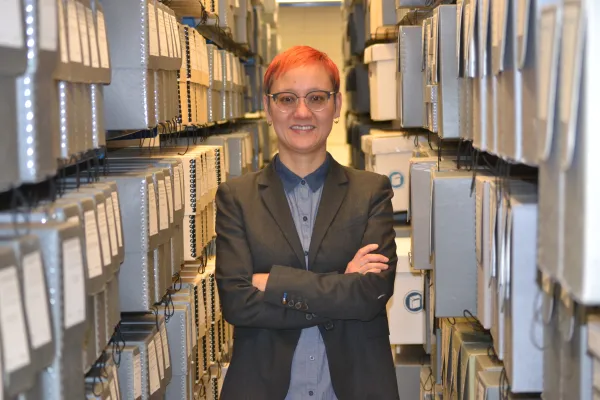“Lead With Love”: Smith’s Activist-in-Residence
Campus Life

Published February 22, 2017
When Miriam Yeung tells people that she is this year’s activist-in-residence at Smith, “their reaction,” she says, “is ‘Wow! There’s a place where that’s actually a position?!’” Yeung—a longtime women's rights, LGBT and reproductive justice organizer—says such innovation is what drew her to Smith.
In addition to leading panel discussions and meeting with students, Yeung—who spent eight years as executive director of the National Asian Pacific American Women’s Forum (NAPAWF)—has been exploring Smith’s distinctive Sophia Smith Collection of women’s history.
“What’s contained here in the archives is really a national treasure,” says Yeung. “Women’s lives and work is a story worth telling—one that can fuel our movements.”
Yeung is also holding weekly conversations with Five College faculty about women of color leading today’s social movements and helping the Steinem Initiative, which sponsors the activist’s residency, design the agenda for an April convening of reproductive justice leaders at Smith.
Here’s what Yeung had to say about being at Smith and the state of women’s organizing:
How did you become Smith’s activist-in-residence?
“I have a long history with Smith College. The organization where I was just executive director, the National Asian Pacific American Women's Forum, has its papers in the Sophia Smith Collection. I also was involved with [Co-Directors] Sara Gould and Joyce Follet in designing the Steinem Initiative—looking at how to make history useful to activists today—and I got to attend the program’s pilot School for Organizers. I’ve been in the movement a long time, and you can’t go far in the gender justice field and notmeet a Smithie.”
What projects are you working on during your residency?
“We kicked off my residency with a January 31 public forum on reproductive justice and resistance. A number of professors have invited me to speak to their classes, including at other campuses in the Five College network. I have also shamelessly plugged the fact that I want to be invited to Smith house teas. What I’m most interested in is being in dialogue with our young leaders. How are they figuring out this moment, and what are their ideas? What are their hopes and dreams for the future? That’s what drives our work as women activists.”
What was your journey to becoming an activist?
“My family immigrated from Hong Kong when I was two. I grew up in New York City with parents who wanted me to become a doctor, lawyer or business person. I came of age as an activist in the time of AIDS, which coincided with my own coming of age as a queer person. From that time, I learned a lesson about persistence, strength and the courage it takes to be our authentic selves. After college, I spent 10 years working at the LGBT Community Center in New York City and then became the center’s director of public policy and government relations. I was the second executive director of NAPAWF, where I worked on campaigns for immigrant rights and economic reproductive justice. Now, I’m taking some time to reflect and read—things you don’t get to do while you’re running an organization.”
What have you learned so far from Smith students?
“The kind of work that Smith students are engaged in right now is the work that all of us in social movements need to be doing. Students are being incredibly introspective and self aware, while at the same time exhibiting intense curiosity. I got to spend some time recently at the Design Thinking Initiative, where students are prototyping new answers and experimenting with building a world that no one has seen before. Young people understand that we don’t have single-issue lives. They see all of the issues we’re working on as connected. We’re at a moment where so many of us are under attack. I’m happy to see that we are not splintering.”
What advice do you have for young activists?
“Lead with love. It’s a hard, intense and dark time, but it’s important not to go into fear or hate. Anger is a strong emotion, but the sustaining fuel we have is love. That’s why I’m asking all of the students I meet, ‘What do you love the most? What do you see as worth fighting for?’ Finding that flame is important. Love burns longer.”